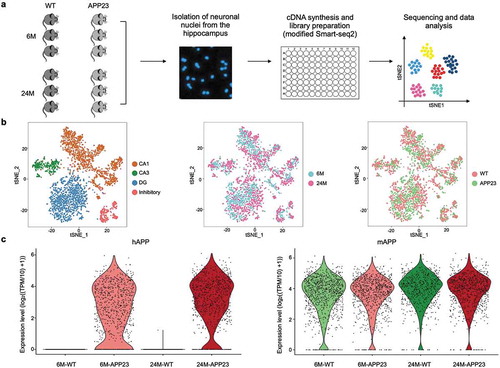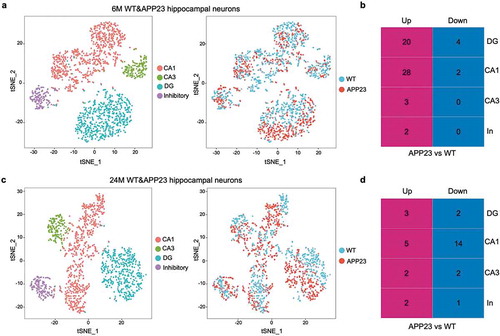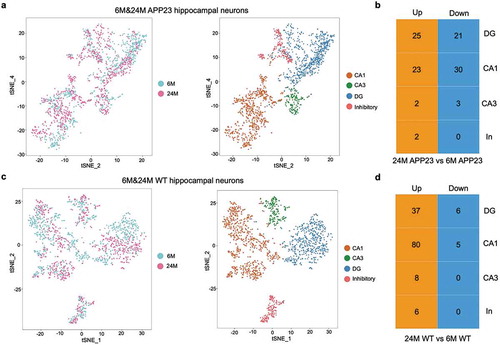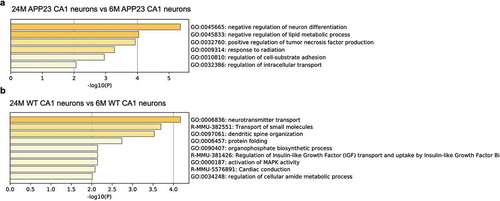Figures & data

Figure 1. Single-nucleus RNA-seq of 6-month-old and 24-month-old WT and APP23 mice hippocampal neurons. (a) Workflow of sample preparation. (b) Cell-type clusters. tSNE embedding of 3,280 single nucleus transcriptional profiles from 6-month-old and 24-month-old WT and APP23 hippocampal neurons. Cells were distinguished by subtype, age and genotype. (c) Violin plots showing the expression level of human APP gene and mouse APP gene in all neuronal nuclei. hAPP, human APP; mAPP, mouse APP.

Figure 2. Classification of 6-month-old and 24-month-old mouse hippocampal neurons. (a) Cell-type clusters of 6-month-old mice hippocampal neurons. tSNE embedding of 1,792 6-month-old APP23 and WT mice hippocampal neurons. Cells were distinguished by subtype and genotype. (b) Number of DEGs between 6-month-old APP23 versus WT hippocampal neurons across subtypes. CA1, CA1 neurons; CA3, CA3 neurons; DG, DG neurons; In, Inhibitory neurons. (c) Cell-type clusters of 24-month-old mice hippocampal neurons. tSNE embedding of 1,488 24-month-old APP23 and WT mice hippocampal neurons. Cells were distinguished by subtype and genotype. (d) Number of DEGs between 24-month-old APP23 versus WT hippocampal neurons across subtypes. CA1, CA1 neurons; CA3, CA3 neurons; DG, DG neurons; In, Inhibitory neurons.

Figure 3. Classification of APP23 and WT mice hippocampal neurons. (a) Cell-type clusters of APP23 hippocampal neurons. tSNE embedding of 1,674 6-month-old and 24-month old APP23 mice hippocampal neurons. Cells were distinguished by age and subtype. (b) Number of DEGs between 24-month-old versus 6-month-old APP23 hippocampal neurons across subtypes. CA1, CA1 neurons; CA3, CA3 neurons; DG, DG neurons; In, Inhibitory neurons. (c) Cell-type clusters of WT hippocampal neurons. tSNE embedding of 1,606 6-month-old and 24-month-old WT mice hippocampal neurons. Cells were distinguished by age and subtype. (d) Number of DEGs between 24-month-old versus 6-month-old WT hippocampal neurons across subtypes. CA1, CA1 neurons; CA3, CA3 neurons; DG, DG neurons; In, Inhibitory neurons.

Figure 4. Gene Ontology (GO) analysis of APP23 and WT mice CA1 neurons during disease progression and aging. (a) Enriched gene ontology terms show the biological processes related to the up-regulated genes in 24-month-old APP23 CA1 neurons versus 6-month-old APP23 CA1 neurons. (b) Enriched gene ontology terms show the biological processes related to the up-regulated genes in 24-month-old WT CA1 neurons versus 6-month-old WT CA1 neurons.

